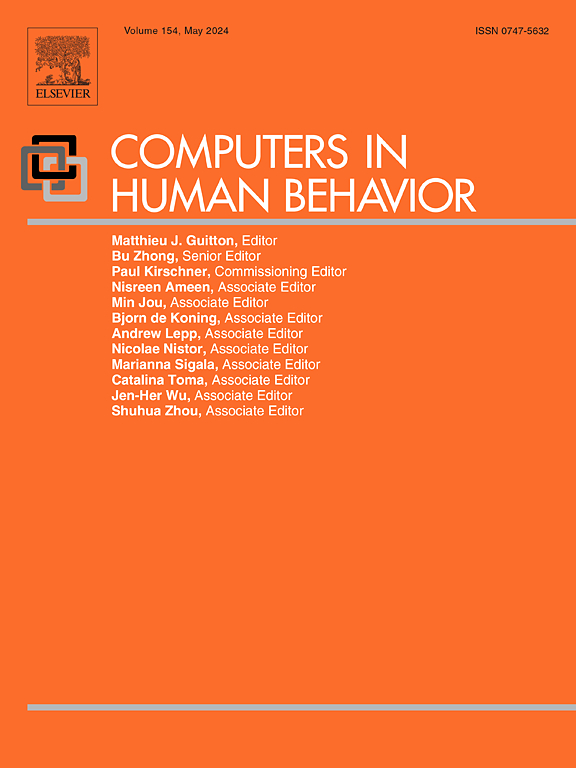When does waiting for a reply turn into ghosting? Individual, relational, and situational predictors of feeling ignored in online messaging
IF 8.9
1区 心理学
Q1 PSYCHOLOGY, EXPERIMENTAL
引用次数: 0
Abstract
Ghosting—the act of ending digital communication without explanation—is increasingly common. While prior research has largely focused on the motives for ghosting and the effects of being ghosted, little is known about when people start to feel ghosted. Understanding this threshold matters to determine at which point delayed replies require coping efforts. We introduce the concept of response delay tolerance: the amount of time someone is willing to wait for a response in online messaging before feeling ignored. We examine how individual traits (rejection sensitivity, fear of missing out, past online exclusion experiences), relational (relationship closeness), and situational factors (chat partner's previous responsiveness, message urgency) shape delay tolerance. In a pre-registered two-part design, we first pretested (N = 98, k = 2352 ratings) closeness, responsiveness, and urgency in 36 chat scenarios. Then, participants (N = 339, k = 8136 ratings) reported the point at which they would begin to feel ignored in each scenario. Results show that both message urgency and chat partner's prior responsiveness, but not closeness, predict shorter delay tolerance. Rejection sensitivity, fear of missing out, and past online exclusion experiences did not predict delay tolerance. Individuals with shorter delay tolerance are more likely to send friendly and confrontational follow-up messages, whereas those with longer tolerance are more inclined to also ignore the chat partner. These findings provide insights into the early, subjective detection of being ignored in digital contexts. They highlight that ghosting begins not with someone leaving but with someone waiting for a response.
什么时候等待回复变成了“鬼影”?在线信息中被忽视感的个体、关系和情境预测因素
“幽灵”——在没有任何解释的情况下终止数字通信的行为——正变得越来越普遍。虽然之前的研究主要集中在“鬼影”的动机和被“鬼影”的影响上,但人们何时开始感到“鬼影”却知之甚少。了解这个阈值对于确定延迟的回复在哪个点需要处理很重要。我们引入了响应延迟容忍的概念:在在线消息传递中,某人愿意等待回复的时间,而不会感到被忽视。我们研究了个人特征(拒绝敏感性、对错过的恐惧、过去的在线排斥经历)、关系(关系亲密)和情境因素(聊天伙伴以前的响应能力、信息紧迫性)如何影响延迟容忍。在预先注册的两部分设计中,我们首先在36个聊天场景中预先测试(N = 98, k = 2352评分)亲密性、响应性和紧迫性。然后,参与者(N = 339, k = 8136)报告他们在每个场景中开始感到被忽视的点。结果表明,消息的紧迫性和聊天伙伴的先前响应性(而不是亲密性)都预示着更短的延迟容忍。排斥敏感性,害怕错过,和过去的在线排斥经历不能预测延迟容忍。延迟容忍度较低的人更有可能发送友好和对抗性的后续信息,而延迟容忍度较长的人更倾向于忽略聊天伙伴。这些发现为在数字环境中被忽视的早期主观检测提供了见解。他们强调,“鬼影”不是从某人离开开始的,而是从某人等待回应开始的。
本文章由计算机程序翻译,如有差异,请以英文原文为准。
求助全文
约1分钟内获得全文
求助全文
来源期刊

Computers in Human Behavior
Multiple-
CiteScore
19.10
自引率
4.00%
发文量
381
审稿时长
40 days
期刊介绍:
Computers in Human Behavior is a scholarly journal that explores the psychological aspects of computer use. It covers original theoretical works, research reports, literature reviews, and software and book reviews. The journal examines both the use of computers in psychology, psychiatry, and related fields, and the psychological impact of computer use on individuals, groups, and society. Articles discuss topics such as professional practice, training, research, human development, learning, cognition, personality, and social interactions. It focuses on human interactions with computers, considering the computer as a medium through which human behaviors are shaped and expressed. Professionals interested in the psychological aspects of computer use will find this journal valuable, even with limited knowledge of computers.
 求助内容:
求助内容: 应助结果提醒方式:
应助结果提醒方式:


